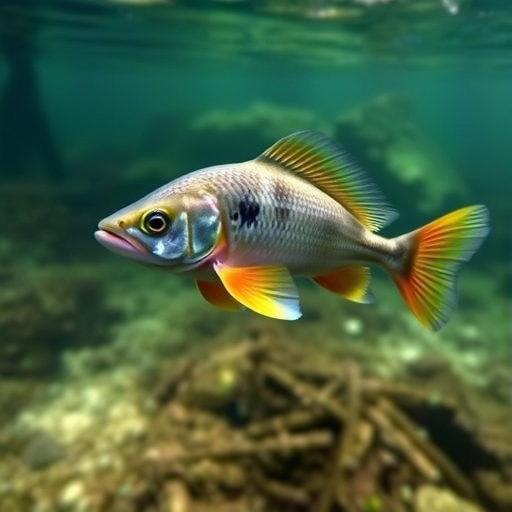In a groundbreaking new study, researchers have delved deep into the intricate dynamics of fish assemblages in the streams of the Atlantic Coast/Northeast Pará hydrographic region of the Eastern Amazon. As a crucial component of freshwater ecosystems, fish play a significant role in biological interactions, influencing nutrient cycling and the stability of aquatic environments. The study, authored by Cunha, Jardim, Almeida, and colleagues, investigates how both environmental factors and human-induced changes shape the diversity and distribution of fish species in these vital habitats.
The research formulates a comprehensive understanding of the factors that control fish assemblages in this remote yet ecologically significant region. By employing a range of field surveys and data analysis methods, the team meticulously mapped out the spatial characteristics of fish populations across various streams. This fieldwork revealed the complex interaction between natural environmental conditions—such as water quality, habitat structure, and seasonal variations—and anthropogenic pressures like deforestation and pollution.
One of the critical findings of the study is the significant impact of water quality on fish assemblage structures. The researchers documented correlations between the presence of specific fish species and levels of pollutants like phosphorus and nitrogen, which are often driven by agricultural runoff and urbanization. This highlights the pressing need for sustainable land use practices to protect aquatic biodiversity. The implications of this work extend beyond academic circles; they underscore the importance of implementing effective conservation policies aimed at safeguarding water quality.
Furthermore, the research suggests that habitat complexity is paramount for maintaining diverse fish communities. The presence of submerged structures, such as logs and rocks, creates microhabitats that provide shelter and breeding grounds for numerous fish species. In contrast, disrupted habitats, often resulting from human activities, can lead to significant declines in species richness. This insight stresses the urgency of restoring and preserving natural habitats to foster resilience in fish populations amidst ongoing environmental changes.
The authors also explored the role of human activities in shaping fish assemblages, finding a direct correlation between urban expansion and a decrease in fish diversity. As populations grow and cities expand, habitats are frequently altered or destroyed, disrupting established ecological balances. This urban sprawl, often marked by increased infrastructure development and pollution, places immense pressure on aquatic ecosystems, necessitating a multi-faceted approach to balance development and conservation.
Interestingly, the researchers observed that certain fish species exhibit resilience to environmental changes, suggesting potential adaptive strategies that enable them to thrive even in modified habitats. This observation serves as a beacon of hope, indicating that under the right conditions, biodiversity can persist despite human pressures. It encourages further studies into the adaptive capacities of fish species, directing research toward conservation strategies that exploit these adaptations.
Moreover, the study sheds light on the potential cascading effects of fish population declines on broader ecosystem health. Reduced fish diversity can lead to imbalances in food webs, ultimately affecting species interactions and ecosystem functionality. This interconnectedness underscores the importance of integrated management approaches that consider all aspects of the ecosystem rather than treating fish populations in isolation.
The authors advocate for continuous monitoring and assessment of aquatic environments to inform better management practices. Establishing long-term ecological studies would provide critical insights into the dynamics of fish assemblages and enable the detection of trends, allowing for timely interventions when necessary. The researchers emphasize that proactive measures, rather than reactive approaches, are essential for conserving the rich biodiversity of the Eastern Amazon’s waterways.
Notably, the implications of this research extend beyond regional boundaries. As climate change continues to exert pressure on freshwater ecosystems globally, the methodologies and findings of this study can serve as models for other regions facing similar challenges. By understanding how multifaceted factors influence aquatic biodiversity, stakeholders worldwide can devise tailored strategies to manage and protect fish populations effectively.
As the research community continues to unravel the complexities of aquatic ecosystems, the insights from this study reiterate the interconnectedness of environmental health and biodiversity. It becomes increasingly clear that safeguarding water resources and habitats is not merely a local concern, but a global imperative that resonates with pressing environmental sustainability goals.
In summary, the critical analysis presented by Cunha et al. lays a foundation for future research into fish assemblages in the face of anthropogenic pressures. Their work forms a vital part of the discourse on conservation and sustainable management of freshwater ecosystems, emphasizing the necessity of understanding the delicate balance between human activities and ecological integrity. The findings underscore not just the challenges but also the potential paths forward, prioritizing resilience and adaptation in both ecological and socio-economic spheres.
As we forge ahead, the lessons gleaned from this research remind us of our responsibility to preserve the intricate web of life that sustains our planets, such as the unique and diverse aquatic environments of the Eastern Amazon. By fostering a deeper understanding of these ecosystems, we can work collectively toward solutions that benefit both nature and humanity.
Subject of Research: Fish assemblages and environmental and anthropogenic factors in Eastern Amazon streams.
Article Title: The role of environmental and anthropogenic factors in shaping fish assemblages of streams of the Atlantic Coast/Northeast Pará hydrographic region, Eastern Amazon.
Article References: Cunha, E.J.S., Jardim, A.A.J., Almeida, M.S. et al. The role of environmental and anthropogenic factors in shaping fish assemblages of streams of the Atlantic Coast/Northeast Pará hydrographic region, Eastern Amazon. Environ Monit Assess 197, 1370 (2025). https://doi.org/10.1007/s10661-025-14819-4
Image Credits: AI Generated
DOI: https://doi.org/10.1007/s10661-025-14819-4
Keywords: fish assemblages, environmental factors, anthropogenic factors, biodiversity, Eastern Amazon, conservation, freshwater ecosystems, habitat complexity.




